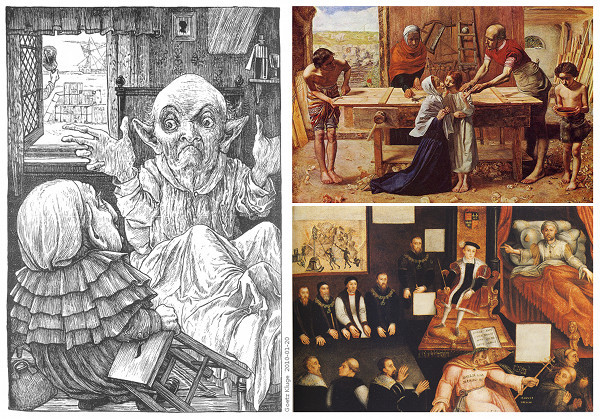User:Goetzkluge
From The Art and Popular Culture Encyclopedia
| Revision as of 06:35, 23 March 2010 Goetzkluge (Talk | contribs) ← Previous diff |
Revision as of 23:57, 23 March 2010 Goetzkluge (Talk | contribs) (grammar) Next diff → |
||
| Line 2: | Line 2: | ||
| Left: [[Henry Holiday|Henry Holiday's]] depiction of the Baker's uncle (in [[Lewis Carroll|Lewis Carroll's]] ''[[The Hunting of the Snark]]'', 1876) with some of the Baker's 42 boxes outside of the window.<br> | Left: [[Henry Holiday|Henry Holiday's]] depiction of the Baker's uncle (in [[Lewis Carroll|Lewis Carroll's]] ''[[The Hunting of the Snark]]'', 1876) with some of the Baker's 42 boxes outside of the window.<br> | ||
| Right top: John Everett Milais: ''Christ in the House of his Parents'' (aka ''The Carpenter's Shop'', 1850, Pre-Raphaelite) with a flock of sheep outside of the window symbolizing the the laity).<br> | Right top: John Everett Milais: ''Christ in the House of his Parents'' (aka ''The Carpenter's Shop'', 1850, Pre-Raphaelite) with a flock of sheep outside of the window symbolizing the the laity).<br> | ||
| - | Right bottom: ''Edward VI and the Pope: An Allegory of Reformation'' (mirrored view, 16<small><sup>th</sup></small> century) with a violence scene of the reformation depicted outside of the window. Thomas Cranmer is second from left under the window.<br><br> | + | Right bottom: ''Edward VI and the Pope: An Allegory of Reformation'' (mirrored view, 16<small><sup>th</sup></small> century) with a violent scene of the reformation depicted outside of the window. Thomas Cranmer is second from left under the window.<br><br> |
| I think, Millais quoted from the 16<small><sup>th</sup></small> century painting: The red flower in Millais' window corresponds to a mutilated body visible through window in the 16<small><sup>th</sup></small> century painting. And Holiday (who perhaps understood Millais' quotes) quoted from Millais' painting as well as from the 16<small><sup>th</sup></small> century painting.]] | I think, Millais quoted from the 16<small><sup>th</sup></small> century painting: The red flower in Millais' window corresponds to a mutilated body visible through window in the 16<small><sup>th</sup></small> century painting. And Holiday (who perhaps understood Millais' quotes) quoted from Millais' painting as well as from the 16<small><sup>th</sup></small> century painting.]] | ||
| I always have been [http://www.allotria.eu/ interested in arts] and did some drawings too, but [http://www.goetzkluge.de/ not too often]. I also like to draw [http://www.allotria.eu/goetzkluge/merkelwalze.pdf cartoons]. | I always have been [http://www.allotria.eu/ interested in arts] and did some drawings too, but [http://www.goetzkluge.de/ not too often]. I also like to draw [http://www.allotria.eu/goetzkluge/merkelwalze.pdf cartoons]. | ||
Revision as of 23:57, 23 March 2010

Right top: John Everett Milais: Christ in the House of his Parents (aka The Carpenter's Shop, 1850, Pre-Raphaelite) with a flock of sheep outside of the window symbolizing the the laity).
Right bottom: Edward VI and the Pope: An Allegory of Reformation (mirrored view, 16th century) with a violent scene of the reformation depicted outside of the window. Thomas Cranmer is second from left under the window.
I think, Millais quoted from the 16th century painting: The red flower in Millais' window corresponds to a mutilated body visible through window in the 16th century painting. And Holiday (who perhaps understood Millais' quotes) quoted from Millais' painting as well as from the 16th century painting.
I always have been interested in arts and did some drawings too, but not too often. I also like to draw cartoons.
As an engineer (semiconductors industry) and as a member of the works council of my company I started to use one of Henry Holiday's illustrations to The Hunting of the Snark in presentations on workload issues (as defined in ISO 10075) since 2007. In December 2008 I accidentally discovered that Henry Holiday quoted from the etching The Image Breakers (or Allegory of Iconoclasm, c. 1566-1568) by Marcus Gheeraerts the Elder. That is how http://holiday.snrk.de/ started.
I assume, that Lewis Carroll's and Henry Holiday's The Hunting of the Snark is about belief and legitimate disputes (Snark) as well as about violent fanaticism (Boojum), especially with regard to the history of Anglicanism. (The Snark also could stand for assuming itself. And if you feed too many greens to your thoughts, they may turn into a Boojum.)
- The Hunting of the Snark
- Lewis Carroll
- Henry Holiday (Holiday's depiction of the Bonnet maker)
- Pre-Raphaelite Brotherhood
- The Banker's Fate
- Marcus Gheeraerts the Elder
- John Everett Millais
- Gustave Doré
- Alfred Parsons (artist)
- Charles Darwin, the HMS Beagle (compared to the ship of the Snark hunting crew) and the vivisection debate (the Beaver's "wrong" lace-making perhaps refers to a memo by Charles Darwin how to use lace-needles together with a microscope for dissection)
- Thomas Cranmer (one of the Baker's personalities; the Baker's 42 boxes perhaps represent Cranmer's 42 Articles)
- Henry George Liddell (Holiday's depiction of the Billiard marker)
- Father Time (Holiday's depiction of the Bellman on the front cover)
Other articles:
Goetz Kluge, 2010-03-21
